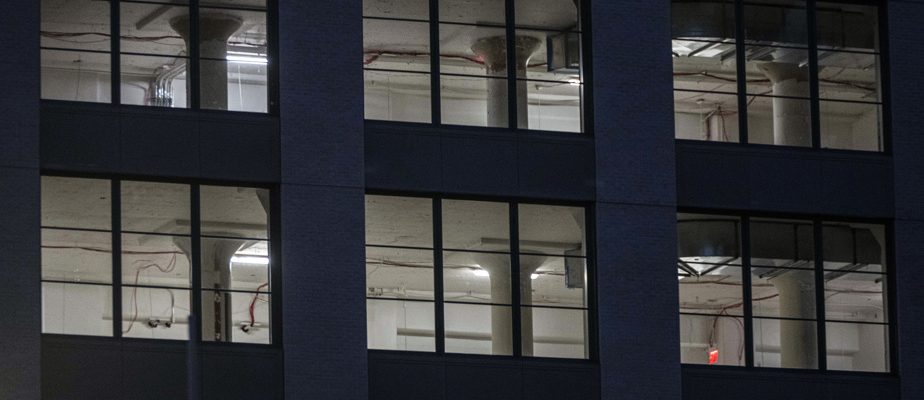In some of the splendid Art Deco buildings that dominate Chicago’s business district, the occupancy rate is 17%.
In Denver, a complex of gleaming towers was worth 176 million US (237 million CAN) when many tenants were crowded there in 2013. It is almost empty today. Its valuation fell to US82 million (CAN111 million), according to the real estate analysis firm Trepp. Even famous buildings in Los Angeles have lost half their value since the start of the pandemic.
From San Francisco to Washington, office towers are caught in an infernal spiral. Many employees who were sent to telework during the pandemic have not returned and interest rates have jumped. Result: the devaluation of an important class of commercial real estate assets. The value of even high-quality office buildings has fallen 35% from its peak in early 2022, according to real estate analytics firm Green Street.
That puts banks that hold much of America’s commercial real estate debt in the hot seat. It will bleed, say analysts and authorities, who are only wondering if it will be a slow hemorrhage or a massacre triggering panic.

PHOTO HARUKA SAKAGUCHI, THE NEW YORK TIMES
Vacant offices in New York. According to a recent study, 14% of commercial real estate loans and 44% of loans linked to office buildings are in the red: the value of the buildings has fallen below the debt taken out.
Last week gave a taste of what’s to come when New York Community Bank revealed unexpected losses on real estate loans linked to office and apartment buildings: the stock crashed.
So far, “the news is ahead of the real impact,” says Trepp executive Lonnie Hendry. “The banks have a pile of unrealized losses in front of them, which are trickling down, but which could come crashing down all at once. »
An expected problem
This subject was worrying in 2023, but this time, we are there. Several banks failed last spring, in part because rising interest rates reduced the value of their assets. There were fears that commercial real estate would have a domino effect on other sectors.
According to Trepp, banks hold $1.4 trillion of the $2.6 trillion in commercial real estate loans that will mature within five years. Small regional banks are particularly exposed.
By 2023, economists and authorities feared it would scare depositors, especially those whose savings exceed the US$250,000 cap set by government insurance, into withdrawing their money. But the public authorities reacted vigorously. They helped sell distressed banks and the Federal Reserve provided cheap bank financing. Confidence in banks was restored and the market moved on.
The problems at the New York Community Bank brought the subject back to the table. According to some analysts, this is an isolated case. This New York bank absorbed Signature Bank on March 20, 2023, which weakened it. So far, few depositors have withdrawn their money from banks.
But the critical situation of this bank brings to the forefront the ills of the sector, even if there is no general panic. This reminds us that the helping hand granted by the Fed last year must expire next month. However, the problems of commercial real estate remain.
It will hurt
Commercial real estate includes retail, rental housing, and factories and other assets. This sector has had a tumultuous few years, office buildings in particular.
According to a recent study by the National Bureau of Economic Research, 14% of commercial real estate loans and 44% of loans related to office buildings are in the red: the value of the buildings has fallen below the debt incurred.
Big lenders like JPMorgan Chase and Bank of America are setting aside money to cover expected losses, but many small and mid-sized banks are downplaying the impact, analysts warn.
Some offices are still officially rented thanks to multi-year leases, but in reality, they are almost empty. Mr. Hendry calls them “zombie offices”: they seem viable, but are not.
Hundreds of banks threatened
However, the recovery of this real estate sector seems a pipe dream. The return to the office has stopped progressing. The Fed has certainly said that it does not intend to raise rates beyond the current 5.25% to 5.5%, but it has made it clear that it is in no hurry to reduce them.
According to Mr. Hendry, the number of defaults could almost double from today and reach 10% or 12% by the end of the year.
The National Bureau of Economic Research study finds that bank assets have been devalued by rising interest rates: growing losses linked to commercial real estate are putting hundreds of small and medium-sized banks at risk.
If uninsured depositors panic and rush to withdraw their money – which brought down banks last March – there could be many bankruptcies.
Authorities on the lookout
The Fed and Treasury Department say they are closely monitoring the banking industry and commercial real estate.
“We have long known that commercial real estate could put financial stability at risk or cause losses in the banking system; it requires careful oversight,” Treasury Secretary Janet Yellen said at a congressional hearing this week.
Interviewed on CBS on Sunday, Fed Chairman Jerome Powell acknowledged that “there will be losses.” For the big banks, he said, the risk was manageable. Regarding regional banks, the Fed is working with them to deal with the expected fallout and some will have to close or merge, Mr. Powell assured.
“This is shaping up to be a problem that we will be dealing with for years,” agrees Mr. Powell. It’s a “considerable” issue, he says, but one that “does not seem to be taking shape like some previous crises, for example the global financial crisis” of 2008.
This article was published in the New York Times.
Read the original version of this article (in English; subscription required)
